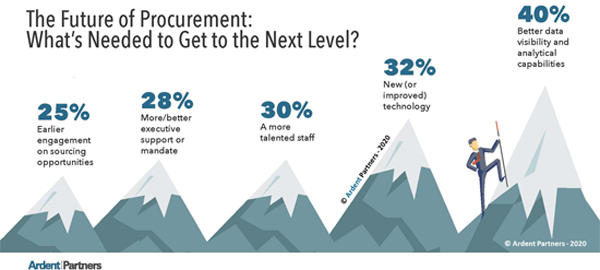Perhaps more than ever, CPOs will need catalysts to drive their teams to the next level of performance. Ardent Partners’ 2020 procurement research asked 340 CPOs to identify the “game-changers” that will propel them forward this decade. Their top answer was “better data visibility and analytical capabilities” selected by 40% of all CPOs making it the most likely catalyst to drive procurement to the next level of performance. Let’s look at what this top game-changer (Big Data Management) means.

The Art & Science of Big Data Management
In 2020, many enterprises struggle with the fundamental ability to manage their data and transform it into actionable intelligence. The same holds true for the procurement and supply chain organizations within them. Procurement professionals are saturated with data, information, and inputs from multiple internal and external sources. Managing this information, much less extracting value from it all can be challenging. In many procurement departments, critical data and information are spread across a labyrinth of disparate applications and systems, many of which lack common formatting and integrated process workflows. Thus, there is often too much duplication, too few hands, and too little time to effectively aggregate, parse, cleanse, and analyze the data.
Despite the current visibility gap experienced by many, innovation has been a boon for procurement and supply chain teams over the last decade. Automated tools have enabled teams to scale their processes and expertise across the enterprise while data analytics and management tools have enabled them to wrangle multiple data streams in order to extract value and make better-informed decisions. For the groups that have visibility into spend and other procurement and supply chain data today, their systems typically capture and process the information and make it available in dashboards and the reporting tools of different business applications. Linking data intelligence to direct decision- making is where the rubber hits the road in value creation with systems today and where top-performing organizations focus their efforts. Processes and outcomes can be improved when key information or intelligence is presented to the professional directly in the context of that person’s specific activities, responsibilities, and decisions.
Most procurement professionals have acknowledged their current challenges with Big Data management; but they also understand the opportunities they have to improve and the role technology will play in aiding them. More specifically, many of these leaders believe that supply management technology, predictive analytics, and data science applied to procurement’s Big Data will have a significant impact on their operations between now and 2022 (and the rest of the decade).
For there to be a real breakthrough, the procurement profession, as “Modern Art” did, must cast away the traditions of the past and embrace experimentation. Modern artists embraced the idea that they were no longer bound to simply describe their subjects for their audience, they were able to present their own interpretations of them. Their collective approach was a dramatic departure from their historical precedents, introducing novel and innovative ideas and materials. In many ways, this era of artists redefined what art was and reimagined what it could be.
CPOs and their teams must adopt a similar mindset in their pursuit of advanced data analysis, and in doing so, they must follow the lead of many other industries and professions that have embraced data science to great effect. In less than a decade, data science and analytics have radically changed professional sports management by redefining the industry’s “common knowledge” and the inputs and capabilities that enable athletes and teams to succeed. Similar changes are happening in medicine where doctors are using large data sets to predict and prescribe medical treatment to cure and, in some cases, preempt illness. Similar opportunities exist for procurement leaders to reimagine their field. The need is for CPOs to not simply think outside the box, but to begin to redefine the box.
RELATED RESEARCH
The Intersection of Data and Sourcing
Intelligent AP – Maximizing Big Data
How Source-to-Settle Solutions Manage (and Leverage) Big Data – eProcurement
How Source-to-Settle Solutions Manage (and Leverage) Big Data – Supply Risk Management

